Studying jazz guitar licks and getting a jazz vocabulary is an important part of learning how to play jazz guitar. Players such as Charlie Parker, Charlie Christian, and Dizzy Gillespie brought fresh levels of excitement to their solos, ushering in a new era of jazz improvisation. In this lesson, you will learn 50 jazz guitar licks, as well as the important concepts behind each lick. This way, you will build your vocabulary and expand your theory knowledge at the same time.
Although the bebop era lasted less than a decade, it had a lasting influence on modern jazz guitar. Subsequent generations of jazz improvisers and guitar players such as Barney Kessel, Joe Pass, George Benson, Kurt Rosenwinkel, and Jim Hall were heavily influenced by bebop.
While many guitarists fall in love with the bebop sound, learning how to play in the bebop style can seem intimidating, but it doesn’t have to be. By learning jazz licks, and the concepts that are used to build those lines, you will bring a bebop vibe to your own jazz solos.

Download Your Free eBook
Download the Beginner's Guide to Jazz Guitar
and start playing today!
Table of Contents
- Jazz Guitar Licks Practice Tips
- Video Licks
- Major II V I Bebop Licks (1-24)
- Short Major II V I Bebop Licks (25-29)
- Minor II V I Bebop Licks (30-35)
- Short Minor II V I Bebop Licks (36-41)
- Jazz Blues Guitar Licks (42-46)
- Rhythm Changes Licks (47-50)
Jazz Guitar Licks Practice Tips
Here are some exercise tips you can use to internalize each lick and add more vocabulary to your jazz guitar improvisation.
- Practice each lick slowly with a metronome. While working slow at first is essential, many jazz and bebop tunes are played at fast tempos, so begin to increase the speed of each lick when you can play it cleanly at a slow tempo. Starting slow and accurate can do wonders to your guitar soloing chops.
- Play each lick in a couple of keys and in at least two different positions on the neck. Most guitar lessons tell you to practice in 12 keys, but I advise you to focus on the most popular ones such as C major, Eb major, A minor, E minor, Bb blues, F blues, ….
- Use backing tracks or Band in a Box so that your ears learn how these jazz guitar phrases sound in a musical context.
- Delve into the concepts and techniques that each lick is built out of. Many jazz guitar lessons give you a series of licks without explaining the building blocks used by your favorite jazz guitar players.
- Construct your own licks using the same techniques and concepts.
- Learn jazz standards such as Autumn Leaves and improvise your own lines using fragments from each lick in your jazz guitar solo. This is the best way to get new vocabulary into your jazz guitar soloing while avoiding becoming a “lick player”.
- Sing each lick while playing the guitar chords.
Video Licks
Before we begin our list of 50 bebop licks, here are two jazz guitar licks that incorporate many of the bebop characteristics in a modern jazz setting.
Both licks are played over a ii V I chord progression in G.
Jazz Guitar Lick #1
This first lick is in the style of Wes Montgomery, one of the greatest jazz guitarists ever. The lick uses a mix of scales and arpeggios that will be explained further on in this lesson.

Jazz Guitar Lick #2
This lick starts with an arpeggio of the minor ii chord before going to a C augmented triad over the D7 chord, a typical bebop device to get a #11 sound.
| Caug triad | C | E | G# |
|---|---|---|---|
| Played over D7 | b7 | 9 | #11 |
The last three bars of the lick use the G major blues scale, hammering on the b3 blues note at the end to bring out a bluesy sound.

Major II V I Jazz Guitar Licks
The 2-5-1 chord progression is one of the most popular chord progressions in bebop and jazz in general.
Because of its popularity, it’s important that you are able to navigate these changes well.
The following 24 licks will give you some options and much-needed variation to play over II V I progressions.
Lick 1
This bebop lick starts with a simple Dorian mode run and continues with a phrase around Abm(add9), the notes of the famous Cry Me A River motif.
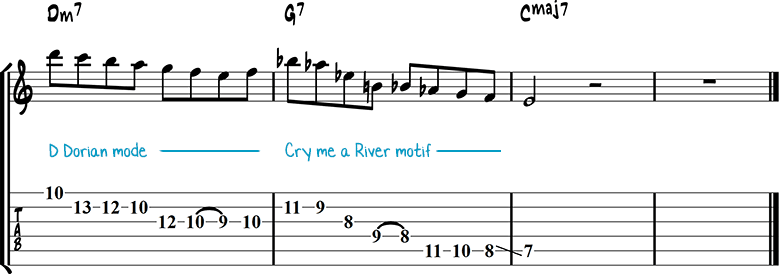
Lick 2
The next two jazz guitar licks start with a simple Dm7 arpeggio pattern that is typical for bebop.
This first variation uses an Abm(add9) arpeggio over the G7 altered chord.

Lick 3
This jazz lick starts with the same Dm7 arpeggio pattern over the minor chord. Instead of an Abm(add9) arpeggio over the G7, this lick uses a Dbmaj7 arpeggio, a different way to play over dominant chords.

Lick 4
This jazz guitar lick starts on the D melodic minor scale and continues with a Dm7 arpeggio on the G7.
Not playing the V (G7), but staying on the ii (Dm7) is something that occurs often in bebop.
This is called minorization, a concept frequently used by Charlie Parker, Pat Martino, and Wes Montgomery.

Lick 5
The next lick uses the G dominant diminished scale over the ii V, going to a G triad in the third bar.

Lick 6
This jazz lick starts with the D Dorian mode and continues with the G Phrygian dominant scale over the G7 chord.
The (G) Phrygian dominant scale is the fifth mode of the (C) harmonic minor scale.

Lick 7
This bebop lick in the style of Tal Farlow uses a number of chromatic notes to outline the ii-V-I underlying chord changes.
- In bar 1, you see the G-Gb-F-E grouping which comes from the G bebop scale, anticipating the G7 by two beats before it arrives in the second bar.
- There is an Abdim7 arpeggio in bar 2 (Ab-Cb-Ebb-Gbb), outlining a G7b9 sound.
- This leads to another set of chromatic notes from Ab to E, the 3rd of Cmaj7.

Lick 8
The following 4 licks start with the same minor bebop pattern in bar 1, with variations on the G7 in the second bar.
This gives you some examples of what you can play over the dominant chord in a ii V I progression.
This first variation uses chromatic approach notes that target the 5 and 3 of G7.

Lick 9
In the second variation, the chord tones of Abm(add9) are used over G7.
This is a common bebop substitution for dominant chords.

Lick 10
Here, the second bar starts with a chromatic run, followed by a Dm7 arpeggio.
Playing a minor arpeggio over a dominant chord is called minorization, the same concept used in lick 4.

Lick 11
In this last variation, the dominant phrase is formed around a voice leading going from 13 to b13.

Lick 12
This lick uses a line cliché in the first bar, a typical voice leading descending chromatically from d to c# to c to b.
In the second bar, I play an Ab diminished arpeggio over G7, a common chord substitution in bebop.
In bar three, I play a series of 6th intervals in the C major scale to finish the phrase.
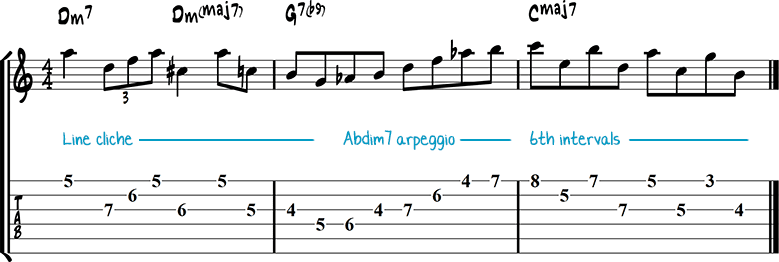
Lick 13
This phrase uses the melodic minor sound, by playing an Fmaj7#5 arpeggio (F-A-C#-E) over Dm7.
There is a nice chromatic approach to the 3rd of G7 at the start of the second bar (A-A#-B) that leads the listener to the chord that is coming next.

Lick 14
The next lick starts with a Dm7 arpeggio and is completely diatonic.
When playing over bebop tunes, you don’t always have to use chromatic notes to outline the changes. Sometimes a diatonic run, such as this, is exactly what the tune needs at that moment in time.
Having a handful of diatonic lines in your vocabulary will ensure you’re able to mix them in comfortably with the chromatic lines in your repertoire.

Lick 15
This lick starts with the Groovin’ High motif, named after the jazz standard written by trumpet player Dizzy Gillespie.

Lick 16
Here, I start with an Fmaj7 arpeggio over Dm7, a common chord substitution.
| Fmaj7 arpeggio | F | A | C | E |
|---|---|---|---|---|
| Played over Dm7 | b3 | 5 | b7 | 9 |
The lick continues with a series of string-skipping intervals in the C harmonic minor scale.

Lick 17
The next lick uses the C harmonic minor scale (=G Phrygian dominant scale) as well.

Lick 18
Here I start with the famous Honeysuckle Rose motif, named after the jazz standard composed by piano player Fats Waller.
The lick continues with the C harmonic minor scale over G7 and finishes with a 1235 pattern in bar three.
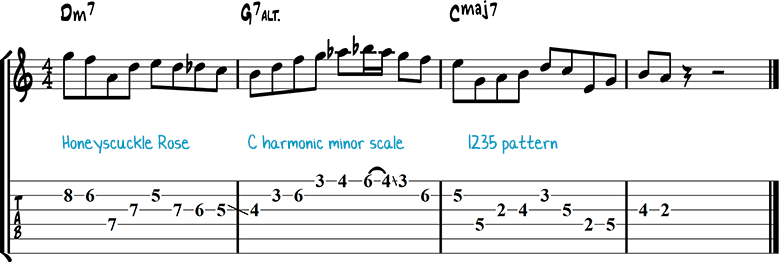
Lick 19
This lick ends with a Cmaj9 arpeggio, before going to the #11 of Cmaj7.

Lick 20
Here, I play the G altered scale over G7, the fifth mode of the C melodic minor scale.

Lick 21
Lick 21 starts with a Dm(add9) run before it goes to the G altered scale in the second bar.
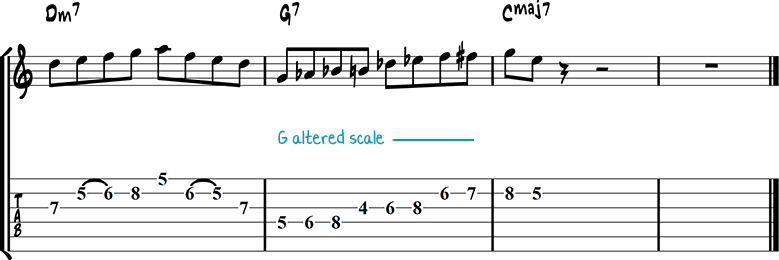
Lick 22
The next jazz guitar lick (in F major) starts with a Gm11 arpeggio and ends with an Am7 arpeggio over Fmaj7.

Lick 23
In this Joe Pass style bebop lick, I use tritone substitution (F#7 over C7) to outline the V7 chord in bar two of the phrase.
When soloing over ii V I changes in a bebop style, you can use the progression ii bII7 I to bring a tritone-sub sound into your solos.
When doing so, you’ll create some added tension to the V7 chord that you resolve into the next bar of the lick. Letting tension hang can cause your line to sound like a mistake, but if you resolve that tension properly, tension such as this can be an effective improvisational tool.
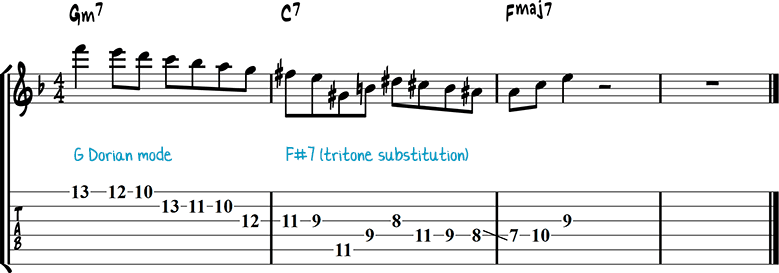
Lick 24
In this Dizzy Gillespie inspired lick, you see a delayed resolution over the Imaj7 chord in the third bar of the phrase.
The C7b9 chord is played over the first beat of the third bar, before resolving to the Fmaj7 chord on the second beat of that bar.
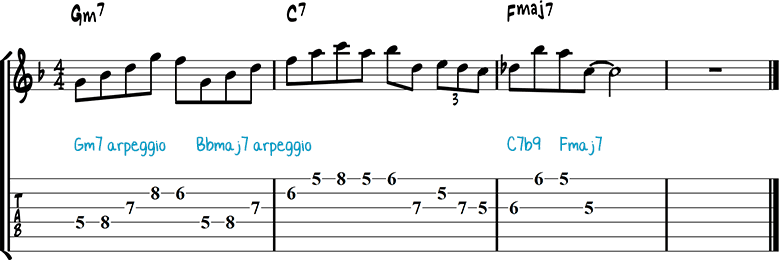
Short Major II V I Jazz Guitar Licks
Besides the long form of the ii V I progression, where the ii and V last one bar, there is also the short ii V I progression, where the ii and V last two beats.
Lick 25
This line has been played by countless jazz musicians over the year. Because of its popularity, it’s another must-know bebop lick to add to your soloing vocabulary.
The lick starts with a leading tone (c#) before running up the iim7 arpeggio and ends with a four-note pattern.

Lick 26
The next lick starts with a sixth interval and ends with an Em7 arpeggio over Cmaj7, the same chord substitution we used in lick 16

Lick 27
Lick 27 is completely diatonic and ends with a typical bebop pattern, a Cmaj7 arpeggio.
This arpeggio pattern is sometimes called the bebop arpeggio. It starts on the 7th, followed by the other three notes of the chord (1-3-5) played in a triplet.

Lick 28
The next phrase comes from John Coltrane and uses diatonic notes and triads in the bebop style.
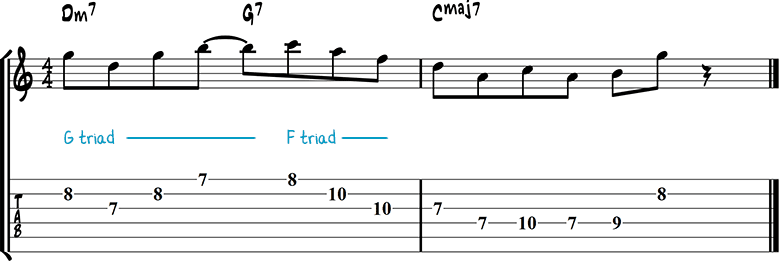
Lick 29

Minor II V I Jazz Guitar Licks
As well as the major ii V I progression, the minor ii V I occurs in almost every jazz standard, so it’s important to have some vocabulary ready for this progression.
Lick 30
This first minor ii V I lick uses the Bbdim7 arpeggio over A7 and an F augmented major chord that brings out the melodic minor sound over D minor.
| Fmaj7#5 arpeggio | F | A | C# | E |
|---|---|---|---|---|
| Played over Dm7 | b3 | 5 | 7 | 9 |

Lick 31
In this Clifford Brown lick, you will see the A Phrygian dominant scale (= D harmonic minor scale) used over the A7alt chord.
The scale actually begins in the second half of the first bar (on note A) and uses the fifth mode of harmonic minor to create a typical bebop run over the next 6 beats. When soloing in the bebop style, the Phrygian dominant scale is the first-choice sound when improvising over V7 chords.

Lick 32

Lick 33
Just as in lick 1, this lick uses the Cry Me A River motif, but this time over a half-diminished chord.

Lick 34

Lick 35
In this lick, a 3 to b9 arpeggio is used over the dominant 7th chord in the second bar.
A 3 to b9 arpeggio is a dim7 arpeggio starting on the third of a dominant chord.

Short Minor II V I Jazz Guitar Licks
The next series of licks are over a short ii V I progression in D minor.
Lick 36
This simple, but effective lick, uses an Em7b5 arpeggio and the D harmonic minor scale.

Lick 37
Lick 37 uses a Gm(add9) arpeggio over Em7b5.

Lick 38
Though arpeggios are mostly used in jazz to outline chords, swing and bebop era players often used the 1-3-5 triad to outline the underlying chord. When working on soloing over bebop changes, don’t forget to spend some time on triads, they’ll come in handy as you use them over bebop tunes.
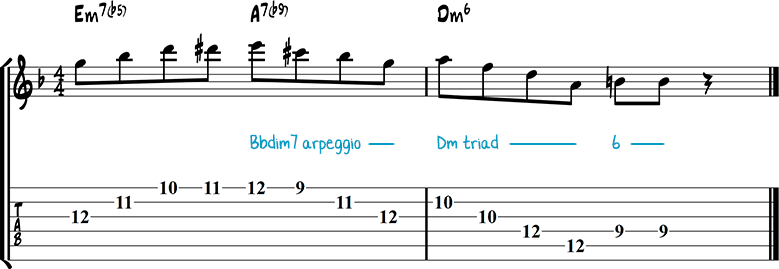
Lick 39
Here’s a classic minor ii V I bebop lick that uses a Bbdim7 arpeggio over the A7alt chord.
When playing a dim7 arpeggio from the 3rd of any 7th chord, you’ll outline the 3-5-b7-b9 intervals of that chord. This is called a 3 to 9 arpeggio, an essential learning for any bebop guitarist.

Lick 40
Lick 40 also has a Bbdim7 arpeggio outlining the V7alt chord as well as a major 7 leading to the tonic in the second bar.
The major 7th, either in an arpeggio or from the melodic minor scale, was a popular note choice over minor chords in the bebop era.
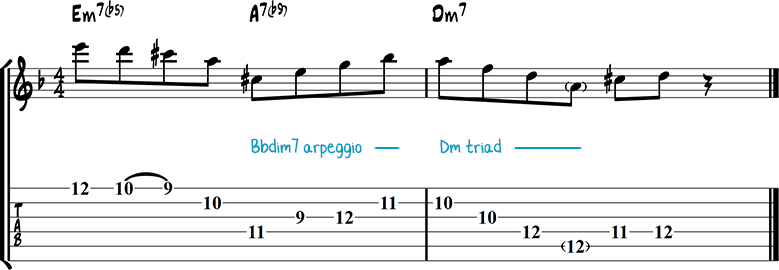
Lick 41
In this short minor ii-V-i phrase, you can hear an enclosure being used around the 3rd of A7alt (Bb-C-C#), as well as the D melodic minor scale being hinted at with the C#-D motion in the last part of the phrase.
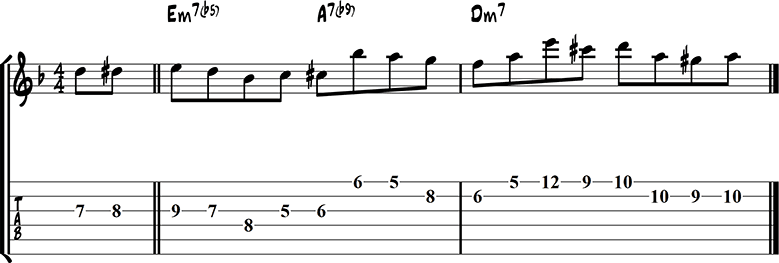
Jazz Blues Guitar Licks
The following jazz guitar licks are played over the first four bars of a jazz blues chord progression in F.
Lick 42
When playing over dominant chords in a bebop blues style, the b7 of the dominant chord is often played in the last part of the phrase to emphasize the transition to the next chord.

Lick 43
The same delay of the b7 is used here at the fourth bar of the jazz blues progression.
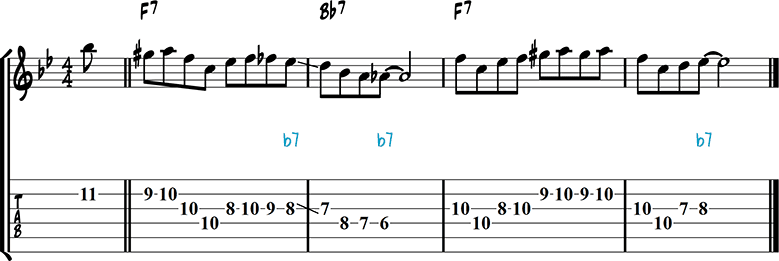
Lick 44
Lick 44 uses the Honeysuckle Rose motif (see lick 18) twice and finishes with the F major pentatonic scale.

Lick 45
This lick starts with the F major pentatonic scale and finishes with the F minor pentatonic scale.

Lick 46
This bebop lick is from the Charlie Parker songbook and is one of the most popular jazz licks of all time.
This lick features the blue notes (b3 and b5). Blue notes come from the blues scale and are an essential tool for jazz blues soloing.
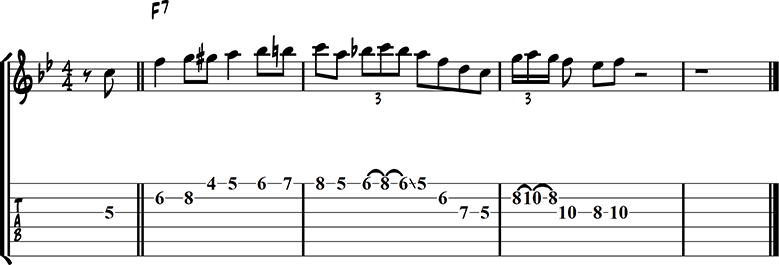
Rhythm Changes Jazz Guitar Licks
One of the most common jazz chord progressions is the rhythm changes progression, named after the jazz standard I Got Rhythm, composed by George Gershwin.
The backbone of a rhythm changes is the I VI II V, a must-know chord progression for every jazz musician.
Lick 47
This series of licks over the first eight bars of a rhythm changes uses a mixture of arpeggios and patterns that are typical for bebop.
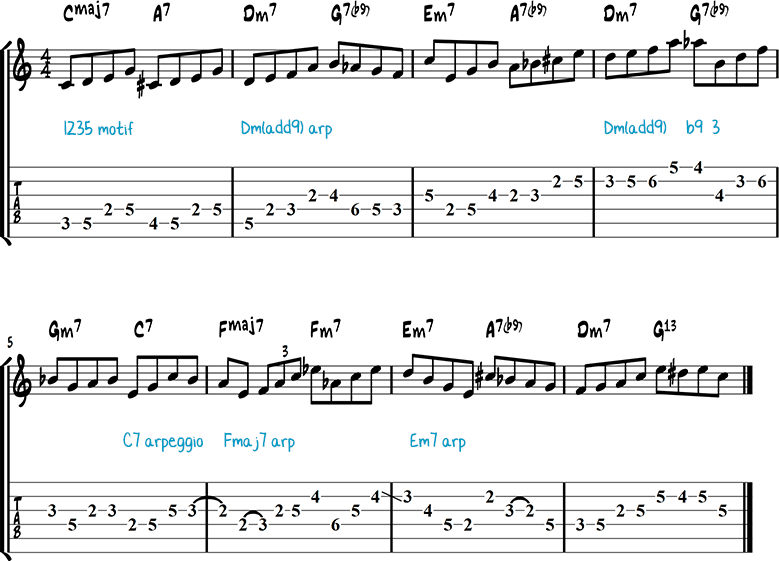
Lick 48
Bebop lick 48 is one of the most common played phrases in bebop (besides “The Lick”).
It features a 3 to b9 jump (on A7 and G7), a typical bebop thing.

Lick 49

Lick 50
This jazz guitar lick demonstrates how ascending four-note patterns can be used to navigate through the 1-6-2-5 harmony.

Now that you have worked on these lines on their own, practice applying them to your soloing when playing over jazz progressions and jazz standards.
More Jazz Guitar Licks




I love this site and have using it for sometime. But now all the backing tracks and play alongside are all screwed and out of sync. Any body experiencing this.? Any suggestions?
Some of the notation above is different than as played. Like in lick 26, you go up the G7 with B but you come down the Em with Bb – in the notation you’re showing coming back down on B
Gold crushed, thank you
Hey I really like this post, even as a piano player. I think it would be a great help to point out more of the enclosures being used, especially when they conflict with some of the scales notated. For example the Lick 6 C harmonic minor on the V chord going into the I – the Db, B is an enclosure of the C.
parabéns pelo trabalho
This has helped me and my students tremendously. Thank you!
I love these lessons and licks!!
Will add to my collection to study but too fast! Can’t hear the accents. I know some folks color the chord tones to help with the reading and beats. Great effort though.
Thanks for the examples! It would like to see a detailed melodic analysis of one of them.
Fantastic stuff. Where can I buy this in book form?
fantastic!
Creating these fantastic jazz guitar lessons must be time consuming…
How do you guys find time to practice and play and gig?
These are truly amazing! Great vocabulary and theory overview.
Time to get these into my fingers – and I play sax by the way!
RESPECT!!
Thank you for the great lesson.
On a side note, I see the list of great jazz players are all male. Was there no female jazz player in history who gave us something to learn from? Emily Remler comes to mind. Any others? Please could we have a lesson on Emily’s playing if you think it is possible?
Great Lesson! Thank you very much Dirk and Co. Examples of jazz standards where the relevant chord progressions occur will also be very helpful.
God bless you dirk all the way to HEAVEN FROM MOTHER AFRICA…..
Thanks for the lessons. Stops the learning feeling solo.
Thanks for all the posts, lots of useful ideas, and tips. Keep them coming.
These are great, not unlike others, I find the ones that have less range you can play in more positions and some of the small ones above span 3 octaves on my guitar. One of my main issues is when I am running it through the cycle of fourths I am fine but then how does one remember all these phrases? Or should we judge ourselves by how many phrases we forgot?!
You have to go through all 3 processes, ingestion, digestion and excretion… What remains with you after digestion is yours for the picking! What you lose by excretion…
well you should know what that is,…
Don’t forget to use soap, water and toilet tissue!
You can spend your whole lifetime trying to memorize licks, never succeed and always sound like somebody else, or you can learn the few principles that are the foundation of bebop. In the last case you are able to invent such phrases on the spot, and that’s where the fun begins. Licks (or listening to the masters) are great to discover small motifs you like and to incorporate them in your thinking. I never learn licks to reproduce them literally.
great way to explain complexities of jazz
GREAAAATTTTT!!!!Thank u!!!! 🙂
Thank’u creat
Once again, very cool!
Great lessons and ideas !!!!
Thanks a lot for sharing all that precious stuff !
Buenísimo, Gracias!
What a nice Jazz guitar lessons ,Dirk you make us great jazz guitarists
another great lesson Dirk !
I really enjoyed those licks, a nice way to start the day!
Another great lesson, thanks Dirk !!!
Nice lesson!
Love your lessons!
Great lessons and ideas !!!!
Thanks a lot for sharing all that precious stuff !